
views
Starting a Jam Session

Round up a small group of musicians. You only need one other musician to jam with, but it is usually best to have at least one rhythm player (drums or percussion) and 1-2 other melody instruments (guitars, bass). While there is no law saying that you can't jam with 15 other people, jam groups generally stay smaller so that every musician can listen in and play off of every other musician. A small group of 3-4 similarly skilled musicians is a good place to start. That said, there are many long-standing groups, such as blues bands, drum groups, and bluegrass bands, that have enormous, open jams, inviting a wide variety of skills and styles. Jamming is non-judgmental and free-form, so just have fun. If you're just starting to improvise, jumping into a large jam session is a great way to get your feet wet without a ton of pressure, as any mistakes you make are less likely to get noticed.
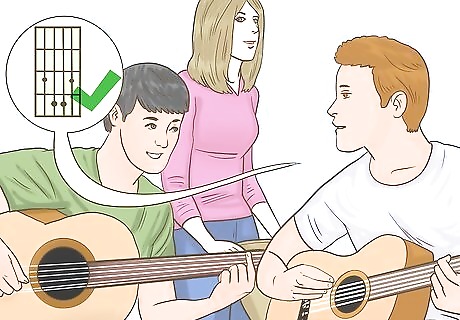
Discuss the chord structure or key of the song. Think of this as the guiding principle of the song. While there will likely be some improvisation and exploration, everyone needs to understand the chords in order to stay together. In general, most jams stick to simple, 3-4 chord songs or melodies that everyone already knows. The point of a jam is not to show off complex, interlocked instrumentals, but to allow each musician the freedom to experiment. Jams can either play established songs, such as the blues jam classic "Stormy Monday," or quickly improvised chord groupings. If you're confused, let someone pick a song and the chords and go from there. If you don't know the chords, sit back and watch another instrument or ask someone playing for advice. If you're a percussionist you should ask about the tempo, or set the tempo yourself if you know the skill levels of your fellow musicians.

Play through the melody of the song 1-2 times so that everyone feels comfortable. In general, you play through the song "as written" briefly, sometimes with vocals, so that everyone gets used to the feel of the song. If you're improvising the song on the spot, this is a good way to get everyone on the same page. Keep the first minute or two simple so that everyone can get used to the structure. Once everyone is on the same page the fun can begin.

Keep your head up as you play. More often than not, one or two people will emerge as the "leaders" of the jam, keeping everyone on time and noting when people should take solos. As you play, keep your head up and watch the other musicians keep the band together. Eye contact, brief signaling, and even talking about upcoming chords or changes will help everyone stay on the same page. As you get more comfortable with your fellow musicians, you can often hear when there is space for a solo and when the rhythm is changing, but you should still be looking up for visual cues from time to time. Watch any improvisational or jam band play live -- you'll notice small moments when the musicians make eye contact through the show, usually before changes, solos, or the song's end.
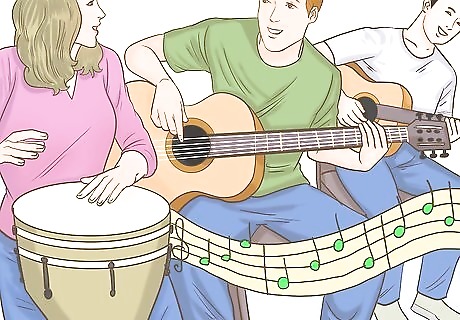
Feel the vibe of the song as it grows. If everyone else starts playing fewer notes, calming the energy down, come down with them. If things start to pick up in volume and intensity, let your own volume grow slowly. In most jams, no one instrument is supposed to take over the entire song. Each player needs to be aware of the rest of the band so that the song grows organically. While you play, listen to the entire sound of the band, not just your own instrument. If you're struggling to keep up with every musician, hone in on the drummer. Follow his lead in energy, tempo, and sound. Feel free to adjust your playing, tempo, or melody, as long as it fits in with the rest of the band. You can help push the song in new directions as long as you don't try and take over the song.

Improvise on the song when it's your turn. Musical improvisation takes a lifetime to master, so you're not expected to whip out a world-class solo on the fly. Improvisation is your chance to see where your instrument takes you, so relax and start experimenting. As long as you remember to stay in key, there is no wrong way to improvise, so just let go and have some fun. If you're new to improv, find a 4-5 note line you like and play it once or twice. Then start to adjust it, changing 1-2 notes each time you play it so you get variations on the same simple theme. If you can mimic the vocal line or a common melody, you'll be sure to keep the song moving. Don't feel the need to show off or be the best. Just play what sounds good to you.
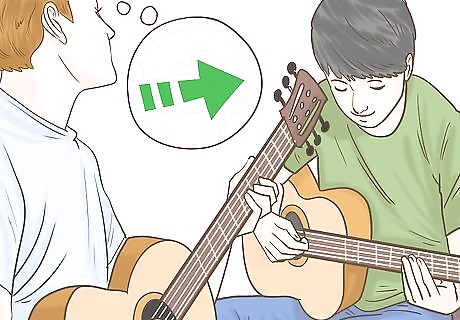
Share the spotlight. A jam is supposed to be an egalitarian, communal environment where everyone can feel free to let loose. No one enjoys it, however, when one person takes all the solos, or decides to solo for 2-3 minutes straight. If you're unsure what the protocol is, just listen into the other plays as they take solos or features. When your turn comes up, play for the same amount of bars (usually eight) as everyone else. That said, some rock and roll groups, usually small, guitar driven bands, will jam on 4-5 minutes solos (see The Grateful Dead, Phish, etc.). It is more about feeling the mood in your particular jam than adhering to a hard and fast rule.
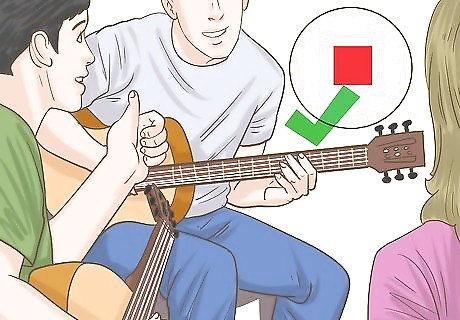
Decide as a group when to end the song. Once everyone's taken a solo, most musicians will start looking around for a cue when to end. In general, once all the musicians have made eye contact, someone will say or signal for "one more round" or to move to the outro, if the song has one. This helps everyone come to an end at the same moment. As the song ends, cut the number of notes or beats you play in half to ease out of the song. It also makes it easier to stop on a dime if you miss the ending cue.
Learning to Jam
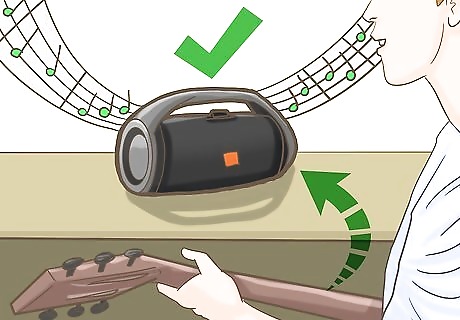
Jam along to your favorite songs at home. One of the best ways to learn to jam is to put on your favorite CD's and just start playing. This helps you train your ear to quickly pick up chord changes, rhythm, and melody, even if you don't necessarily know the song well. Improvisation is a skill that only comes through practice, but that doesn't mean you need a full band with you every time you want to play. Remember to learn the rhythm and backing parts of the songs as well, not just the solos. To succeed in a jam, you need to be a part of the band as well as a willing improviser. If you play with several musicians regularly, ask them for 4-5 songs that they want you to learn, and offer them a few you like to play. The next time you meet your band will have a few more songs to jam on.

Learn the "standards" in your genre. If you're going to a gospel/bluegrass jam, you need to know how to play "I'll Fly Away" and a Johnny Cash song or two. If you're going to a rock or blues jam, you need to know the classic 12-bar blues format ("Stormy Monday," "Everyday I Get the Blues"), and a few Beatles or Rolling Stones songs that everyone knows. If you're a jazz musician, you should have "Summertime," "Heart and Soul," "Bye Bye Blackbird," "Round Midnight" and several other jazz classics down pat. Don't feel like you need to memorize tons of songs before you're able to jam. As you start playing, note the songs that come up frequently and make a point to learn them back to front. In many cases, jamming on a song is actually the best, and fastest, way to learn a song.
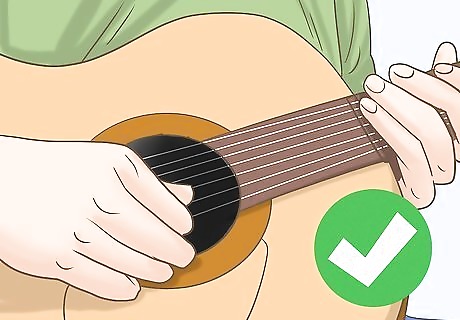
Know your instrument. You should be able to find most notes on your instrument with ease. If you know where everything is you'll be able to quickly learn from others while jamming, picking up new melodies and chords for songs you don't know so well. You need to spend plenty of time practicing on your own, not just showing up and trying to wing it. The better you know your instrument, the more you can stop thinking and start playing.
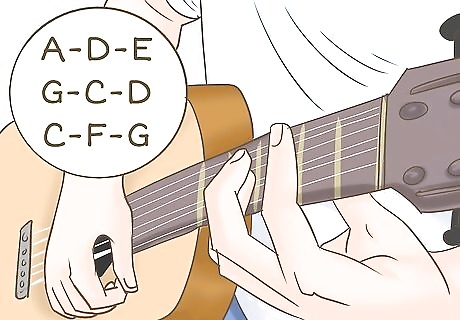
Learn a few common chord structures. You will never know every single chord or song that someone suggests, but having a good mental catalog of songs will help you quickly adapt to whatever song is being played. While it is by no means exhaustive, there are some common chord structures that any band could start with: A - D - E (Frequently in 7ths for blues songs) G - C - D C - F - G G - Am - D C - Am - Dm - G

Learn music theory. While studying theory may seem like the antithesis of good improvisers, quality musicians know that music theory is the secret weapon that helps them adapt in any jam. Knowing song, chord, and scale structures allows you to figure out songs on the fly because you can quickly predict where the song is going. Chords are not smashed together randomly -- there are certain principles and formulas that dictate what sounds good together and how each scale interacts with certain chords. If you want to be a quality jam-player, you need to do your homework.




















Comments
0 comment